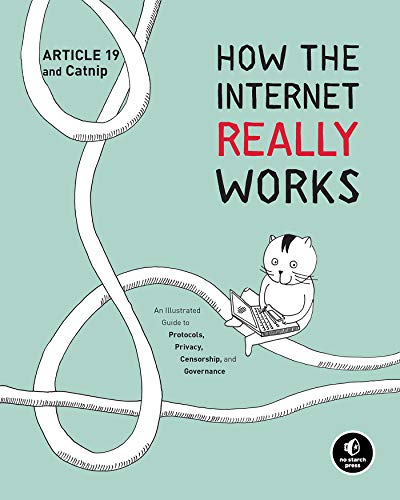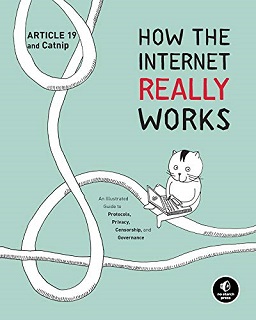
Product details
- Publisher : No Starch Press (December 8, 2020)
- Publication date : December 8, 2020
- Language : English
- File size : 35453 KB
- Print length : 120 pages
- by Article 19 (Author), Mallory Knodel (Contributor), Ulrike Uhlig (Contributor), Niels ten Oever (Contributor), Corinne Cath (Contributor)
- Format : epub、pdf、mobi
An accessible, comic book-like, illustrated introduction to how the internet works under the hood, designed to give people a basic understanding of the technical aspects of the Internet that they need in order to advocate for digital rights.
The internet has profoundly changed interpersonal communication, but most of us don’t really understand how it works. What enables information to travel across the internet? Can we really be anonymous and private online? Who controls the internet, and why is that important? And… what’s with all the cats?
How the Internet Really Works answers these questions and more. Using clear language and whimsical illustrations, the authors translate highly technical topics into accessible, engaging prose that demystifies the world’s most intricately linked computer network. Alongside a feline guide named Catnip, you’ll learn about:
• The “How-What-Why” of nodes, packets, and internet protocols
• Cryptographic techniques to ensure the secrecy and integrity of your data
• Censorship, ways to monitor it, and means for circumventing it
• Cybernetics, algorithms, and how computers make decisions
• Centralization of internet power, its impact on democracy, and how it hurts human rights
• Internet governance, and ways to get involved
This book is also a call to action, laying out a roadmap for using your newfound knowledge to influence the evolution of digitally inclusive, rights-respecting internet laws and policies.
Whether you’re a citizen concerned about staying safe online, a civil servant seeking to address censorship, an advocate addressing worldwide freedom of expression issues, or simply someone with a cat-like curiosity about network infrastructure, you will be delighted — and enlightened — by Catnip’s felicitously fun guide to understanding how the internet really works!
Editorial Reviews
About the Author
ARTICLE 19 is an international non-profit organization that seeks to promote, develop, and protect freedom of expression, including access to information. Headquartered in London, with offices in Bangladesh, Brazil, Kenya, Mexico, Senegal, Tunisia, Myanmar, and the USA, ARTICLE 19 works to bridge the knowledge gap about Internet infrastructure and why it matters for people.
Contributors: Ulrike Uhlig, Mallory Knodel, Niels ten Oever, Corinne Cath
Excerpt. © Reprinted by permission. All rights reserved.
Hi! I’m Catnip.
I’ve written a guide to how the internet works for my fellow cats, I mean people, who use technology, which is most of us. It‘s for those of us who are curious about basic internet infrastructure and how it operates. I‘ve taken these basic concepts and presented them with concise, clear text alongside playful illustrations.
The guide answers questions like these:
How does the internet work?
What enables information to travel across the internet?
What interferes with information traveling across the internet?
What information is shared about users when accessing the internet?
What control do machines have?
Who controls the internet?
How is power over the decentralized internet distributed?
The chapters are broken down into questions about larger technological concepts such as transport protocols, security and privacy, algorithms and internet infrastructure governance. The guide progresses from the most fundamental concepts of how the internet works to the more complex concepts, so while each chapter is self-contained, reading from the beginning will ensure that your conceptual construction is built on foundational knowledge.
The guide ends with a chapter on how to shape the internet as an important stakeholder: the user. It is critical to expand participation in internet governance and standards setting to currently underrepresented populations in technology. Furthermore, those who approach the development and use of technology in the public interest have a key role to play in ensuring that the internet, at a structural level, becomes a medium that enables social justice and human rights.
The information contained in this guide is best seen as supplementary to a practice, such as in a workshop or course, or for internet policy practitioners whose work can be strengthened with technical backing, for just two examples.
You can reach out to us with your interest or questions on all of the above on https://catnip.article19.org!



